
Defi nitions: Safety Guidelines
The defi nitions below describe the level of severity for each signal word. Please read the
manual and pay attention to these symbols.
DANGER: Indicates an imminently hazardous situation which, if not avoided, will
result in death or serious injury.
WARNING: Indicates a potentially hazardous situation which, if not avoided, could result
in death or serious injury.
CAUTION: Indicates a potentially hazardous situation which, if not avoided, may result
in minor or moderate injury.
NOTICE: Indicates a practice not related to personal injury which, if not avoided, may
result in property damage.
IF YOU HAVE ANY QUESTIONS OR COMMENTS ABOUT THIS OR ANY DEWALT TOOL, CALL
US TOLL FREE AT: 1-800-4-D
EWALT (1-800-433-9258).
WARNING: To reduce the risk of injury, read the instruction manual.
General Power Tool Safety Warnings
WARNING! Read all safety warnings and all instructions. Failure to follow the
warnings and instructions may result in electric shock, fi re and/or serious injury.
SAVE ALL WARNINGS AND INSTRUCTIONS
FOR FUTURE REFERENCE
The term “power tool” in the warnings refers to your mains-operated (corded) power tool or
battery-operated (cordless) power tool. This worklight is a power tool.
1) WORK AREA SAFETY
a) Keep work area clean and well lit. Cluttered or dark areas invite accidents.
b) Do not operate power tools in explosive atmospheres, such as in the presence of
fl ammable liquids, gases or dust. Power tools create sparks which may ignite the dust
or fumes.
c) Keep children and bystanders away while operating a power tool. Distractions can
cause you to lose control.
2) ELECTRICAL SAFETY
a) Power tool plugs must match the outlet. Never modify the plug in any way. Do
not use any adapter plugs with earthed (grounded) power tools. Unmodifi ed plugs
and matching outlets will reduce risk of electric shock.
b) Avoid body contact with earthed or grounded surfaces such as pipes, radiators,
ranges and refrigerators. There is an increased risk of electric shock if your body is
earthed or grounded.
c) Do not expose power tools to rain or wet conditions. Water entering a power tool will
increase the risk of electric shock.
d) Do not abuse the cord. Never use the cord for carrying, pulling or unplugging
the power tool. Keep cord away from heat, oil, sharp edges or moving parts.
Damaged or entangled cords increase the risk of electric shock.
e) When operating a power tool outdoors, use an extension cord suitable for
outdoor use. Use of a cord suitable for outdoor use reduces the risk of electric shock.
f) If operating a power tool in a damp location is unavoidable, use a ground fault
circuit interrupter (GFCI) protected supply. Use of a GFCI reduces the risk of electric
shock.
3) PERSONAL SAFETY
a) Stay alert, watch what you are doing and use common sense when operating a
power tool. Do not use a power tool while you are tired or under the infl uence of
drugs, alcohol or medication. A moment of inattention while operating power tools may
result in serious personal injury.
b) Use personal protective equipment. Always wear eye protection. Protective
equipment such as dust mask, non-skid safety shoes, hard hat, or hearing protection
used for appropriate conditions will reduce personal injuries.
c) Prevent unintentional starting. Ensure the switch is in the off position before
connecting to power source and/or battery pack, picking up or carrying the tool.
Carrying power tools with your fi nger on the switch or energizing power tools that have the
switch on invites accidents.
d) Remove any adjusting key or wrench before turning the power tool on. A wrench
or a key left attached to a rotating part of the power tool may result in personal injury.
e) Do not overreach. Keep proper footing and balance at all times. This enables better
control of the power tool in unexpected situations.
f) Dress properly. Do not wear loose clothing or jewelry. Keep your hair, clothing
and gloves away from moving parts. Loose clothes, jewelry or long hair can be caught
in moving parts.
g) If devices are provided for the connection of dust extraction and collection
facilities, ensure these are connected and properly used. Use of dust collection can
reduce dust-related hazards.
4) POWER TOOL USE AND CARE
a) Do not force the power tool. Use the correct power tool for your application. The
correct power tool will do the job better and safer at the rate for which it was designed.
b) Do not use the power tool if the switch does not turn it on and off. Any power tool
that cannot be controlled with the switch is dangerous and must be repaired.
c) Disconnect the plug from the power source and/or the battery pack from the
power tool before making any adjustments, changing accessories, or storing
power tools. Such preventive safety measures reduce the risk of starting the power tool
accidentally.
d) Store idle power tools out of the reach of children and do not allow persons
unfamiliar with the power tool or these instructions to operate the power tool.
Power tools are dangerous in the hands of untrained users.
e) Maintain power tools. Check for misalignment or binding of moving parts,
breakage of parts and any other condition that may affect the power tool’s
operation. If damaged, have the power tool repaired before use. Many accidents
are caused by poorly maintained power tools.
f) Keep cutting tools sharp and clean.
Properly maintained cutting tools with sharp
cutting edges are less likely to bind and are easier to control.
INSTRUCTION MANUAL
GUIDE D’UTILISATION
MANUAL DE INSTRUCCIONES
DCL050 20V Max* LED Hand-Held Area Worklight
Lampe d’atelier DEL portable DCL050, 20V max*
Luz de trabajo LED portátil DCL050 de 20V Máx*
INSTRUCTIVO DE OPERACIÓN, CENTROS DE SERVICIO
Y PÓLIZA DE GARANTÍA.
ADVERTENCIA: LÉASE ESTE
INSTRUCTIVO ANTES DE USAR EL PRODUCTO.
DeWALT Industrial Tool Co., 701 East Joppa Road, Baltimore, MD 21286
(JAN14) Part No. N357119 DCL050 Copyright © 2014 D
EWALT
The following are trademarks for one or more DeWALT power tools: the yellow and black color scheme; the “D” shaped
air intake grill; the array of pyramids on the handgrip; the kit box confi guration; and the array of lozenge-shaped humps on
the surface of the tool.
g) Use the power tool, accessories and tool bits, etc. in accordance with these
instructions, taking into account the working conditions and the work to be
performed. Use of the power tool for operations different from those intended could
result in a hazardous situation.
5) BATTERY TOOL USE AND CARE
a) Recharge only with the charger specifi ed by the manufacturer. A charger that
is suitable for one type of battery pack may create a risk of fi re when used with another
battery pack.
b) Use power tools only with specifi cally designated battery packs. Use of any other
battery packs may create a risk of injury and fi re.
c) When battery pack is not in use, keep it away from other metal objects, like
paper clips, coins, keys, nails, screws, or other small metal objects, that can
make a connection from one terminal to another. Shorting the battery terminals
together may cause burns or a fi re.
d) Under abusive conditions, liquid may be ejected from the battery; avoid contact. If
contact accidentally occurs, fl ush with water. If liquid contacts eyes, additionally
seek medical help. Liquid ejected from the battery may cause irritation or burns.
6) SERVICE
a) Have your power tool serviced by a qualifi ed repair person using only identical
replacement parts. This will ensure that the safety of the power tool is maintained.
Specifi c Safety Rules for Worklights
WARNING: Fire hazard. Do not operate worklight near fl ammable liquids or in gaseous or
explosive atmospheres. Internal sparks may ignite fumes causing personal injury.
• Do not expose light to wet or damp areas. Do not expose light to rain or snow.
• Do not wash light with water or allow water to get inside light. Do not submerge light in water
at any time.
WARNING: Do not place the worklight in a position which may cause anyone to
intentionally or unintentionally stare into the light. Serious eye injury could result.
CAUTION: When not in use, place light on its side on a stable surface where it will
not cause a tripping or falling hazard. Some products with large battery packs will stand
upright on the battery pack but may be easily knocked over.
• The label on your worklight may include the following symbols. The symbols and their
defi nitions are as follows:
V ..................... volts A ........................ amperes
Hz ................... hertz W ....................... watts
min .................minutes
or AC ............alternating current
or DC .....direct current or AC/DC .....alternating or direct current
...................Class I Construction
n
o.......................no load speed
(grounded) n .........................rated speed
...................Class II Construction ....................... earthing terminal
(double insulated)
.......................safety alert symbol
…/min ............per minute BPM ...................beats per minute
IPM .................impacts per minute RPM ...................revolutions per minute
SPM ...............strokes per minute sfpm ...................surface feet per minute
Important Safety Instructions for All Battery Packs
When ordering replacement battery packs, be sure to include the catalog number and voltage.
Consult the chart at the end of this manual for compatibility of chargers and battery packs.
The battery pack is not fully charged out of the carton. Before using the battery pack and
charger, read the safety instructions below and then follow charging procedures outlined.
READ ALL INSTRUCTIONS
• Do not charge or use the battery pack in explosive atmospheres, such as in the
presence of fl ammable liquids, gases or dust. Inserting or removing the battery pack
from the charger may ignite the dust or fumes.
• NEVER force the battery pack into the charger. DO NOT modify the battery pack in
any way to fi t into a non-compatible charger as battery pack may rupture causing
serious personal injury. Consult the chart at the end of this manual for compatibility of
batteries and chargers.
• Charge the battery packs only in designated D
EWALT chargers.
• DO NOT splash or immerse in water or other liquids.
• Do not store or use the tool and battery pack in locations where the temperature
may reach or exceed 105°F (40°C) (such as outside sheds or metal buildings in
summer). For best life store battery packs in a cool, dry location.
NOTE: Do not store the battery packs in a tool with the trigger switch locked on.
Never tape the trigger switch in the ON position.
WARNING: Fire hazard. Never attempt to open the battery pack for any reason. If the battery
pack case is cracked or damaged, do not insert into the charger. Do not crush, drop or damage
the battery pack. Do not use a battery pack or charger that has received a sharp blow, been
dropped, run over or damaged in any way (e.g., pierced with a nail, hit with a hammer, stepped
on). Damaged battery packs should be returned to the service center for recycling.
WARNING: Fire hazard. Do not store or carry the battery pack so that metal objects
can contact exposed battery terminals. For example, do not place the battery pack in
aprons, pockets, tool boxes, product kit boxes, drawers, etc., with loose nails, screws, keys, etc.
Transporting batteries can possibly cause fi res if the battery terminals inadvertently
come in contact with conductive materials such as keys, coins, hand tools and the
like. The US Department of Transportation Hazardous Material Regulations (HMR) actually
prohibit transporting batteries in commerce or on airplanes (e.g., packed in suitcases and carry-
on luggage) UNLESS they are properly protected from short circuits. So when transporting
individual battery packs, make sure that the battery terminals are protected and well insulated
from materials that could contact them and cause a short circuit.
SPECIFIC SAFETY INSTRUCTIONS FOR LITHIUM ION (Li-Ion)
• Do not incinerate the battery pack even if it is severely damaged or is completely
worn out. The battery pack can explode in a fi re. Toxic fumes and materials are created
when lithium ion battery packs are burned.
• If battery contents come into contact with the skin, immediately wash area with
mild soap and water. If battery liquid gets into the eye, rinse water over the open eye for
15 minutes or until irritation ceases. If medical attention is needed, the battery electrolyte is
composed of a mixture of liquid organic carbonates and lithium salts.
• Contents of opened battery cells may cause respiratory irritation. Provide fresh air. If
symptoms persist, seek medical attention.
WARNING: Burn hazard. Battery liquid may be fl ammable if exposed to spark or fl ame.
The RBRC™ Seal
The RBRC™ (Rechargeable Battery Recycling Corp oration) Seal on the nickel
cadmium, nickel metal hydride or lithium ion batteries (or battery packs) indicate
that the costs to recycle these batteries (or battery packs) at the end of their useful
life have already been paid by D
EWALT. In some areas, it is illegal to place spent
nickel cadmium, nickel metal hydride or lithium ion batteries in the trash or
municipal solid waste stream and the RBRC™ program provides an environmentally
conscious alternative.
RBRC™, in cooperation with D
EWALT and other battery users, has established programs in
the United States and Canada to facilitate the collection of spent nickel cadmium, nickel metal
hydride or lithium ion batteries. Help protect our environment and conserve natural resources by
returning the spent nickel cadmium, nickel metal hydride or lithium ion batteries to an authorized
D
EWALT service center or to your local retailer for recycling. You may also contact your local
recycling center for information on where to drop off the spent battery.
RBRC™ is a registered trademark of the Rechargeable Battery Recycling Corporation.
Important Safety Instructions for All Battery Chargers
SAVE THESE INSTRUCTIONS: This manual contains important safety and operating
instructions for battery chargers.
• Before using the charger, read all instructions and cautionary markings on the charger, battery
pack and product using the battery pack.
WARNING: Shock hazard. Do not allow any liquid to get inside the charger. Electric shock
may result.
CAUTION: Burn hazard. To reduce the risk of injury, charge only DEWALT
rechargeable battery packs. Other types of batteries may overheat and burst resulting in
personal injury and property damage.
NOTICE: Under certain conditions, with the charger plugged into the power supply, the charger
can be shorted by foreign material. Foreign materials of a conductive nature, such as, but not
limited to, grinding dust, metal chips, steel wool, aluminum foil or any buildup of metallic particles
should be kept away from the charger cavities. Always unplug the charger from the power supply
when there is no battery pack in the cavity. Unplug the charger before attempting to clean.
• DO NOT attempt to charge the battery pack with any chargers other than the ones
in this manual. The charger and battery pack are specifi cally designed to work together.
• These chargers are not intended for any uses other than charging D
EWALT
rechargeable batteries. Any other uses may result in risk of fi re, electric shock or
electrocution.
• Do not expose the charger to rain or snow.
• Pull by the plug rather than the cord when disconnecting the charger. This will reduce
the risk of damage to the electric plug and cord.
• Make sure that the cord is located so that it will not be stepped on, tripped over or
otherwise subjected to damage or stress.
• Do not use an extension cord unless it is absolutely necessary. Use of improper
extension cord could result in risk of fi re, electric shock or electrocution.
• When operating a charger outdoors, always provide a dry location and use an
extension cord suitable for outdoor use. Use of a cord suitable for outdoor use reduces
the risk of electric shock.
• An extension cord must have adequate wire size (AWG or American Wire Gauge)
for safety. The smaller the gauge number of the wire, the greater the capacity of the cable,
that is, 16 gauge has more capacity than 18 gauge. An undersized cord will cause a drop in
line voltage resulting in loss of power and overheating. When using more than one extension
to make up the total length, be sure each individual extension contains at least the minimum
wire size. The following table shows the correct size to use depending on cord length and
nameplate ampere rating. If in doubt, use the next heavier gauge. The lower the gauge
number, the heavier the cord.
If you have questions or comments, contact us.
Pour toute question ou tout commentaire, nous contacter.
Si tiene dudas o comentarios, contáctenos.
1-800-4-DEWALT • www.dewalt.com

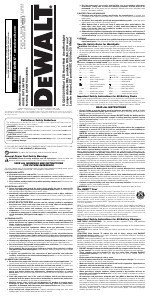


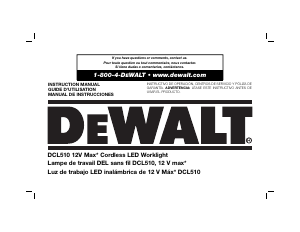
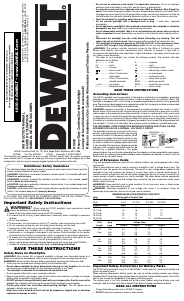
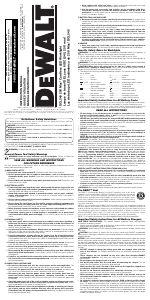
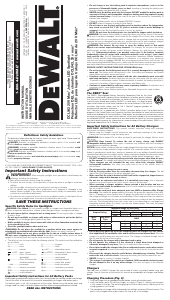
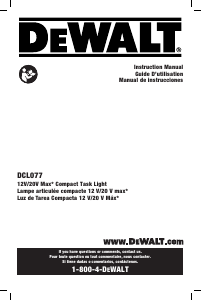
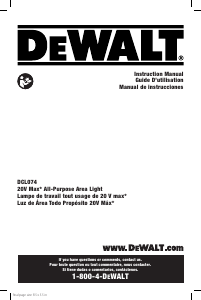
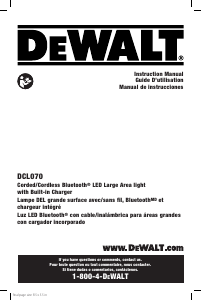
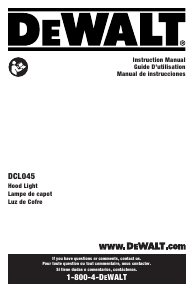
Únase a la conversación sobre este producto
Aquí puedes compartir lo que piensas sobre DeWalt DCL050 Lámpara. Si tiene alguna pregunta, primero lea atentamente el manual. Puede solicitar un manual utilizando nuestro formulario de contacto.